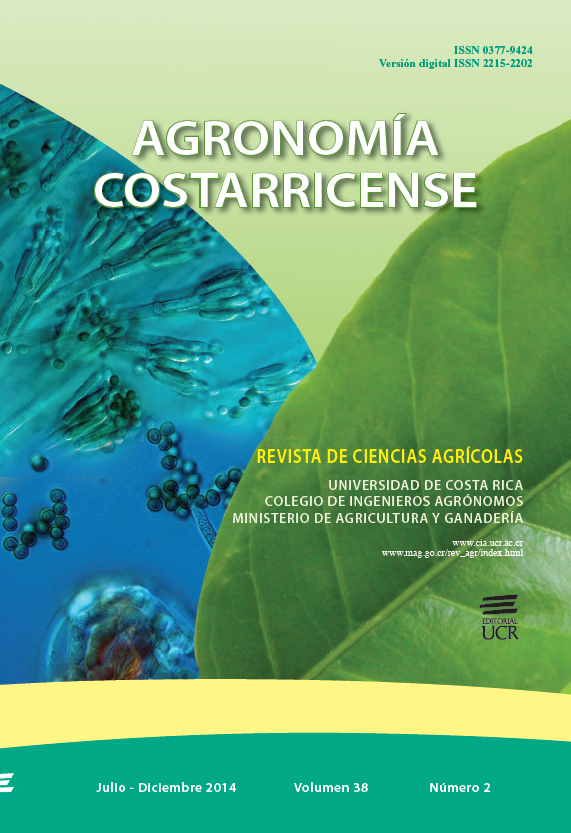Abstract
The effect of implementing 6 doses of compost plus a control, interacting with the nematicide application or non-application, on the dynamics of the soil microorganisms population (bacteria, fungi and actinomycetes), the phytoparasite nematode populations and the root system health of the banana crop, were evaluated. The results did not show any difference in microorganism populations in relation to the different compost dose or to the nematicide implementation or non implementation. Regarding the biological diversity idexes, in the fungus populations no differences were obtained according to the compost dose, but they were in regard to the nematicide application or non-application, being larger with the richness variable in the first case. The root system health did not differ with the different compost doses, nor with or without nematicide; there were only differences depending on the sampling carried out. Finally, the phytoparasite nematode populations did not show any difference due to the compost dose, except for Pratylenchus. As regards to the nematicide application, all populations were larger in the area where no nematicide was applied.References
AKHTAR M., ABDUL M. 2000. Roles of soil amendments and soil organisms in the biological control of plant parasitic nematodes: a review. Bioresource Technology 74:35-47.
AKHTAR M., MAHMOOD I. 1995. Control of root-knot nematode Meloidogyne incognita in tomato plants by seed coating with Achook and neem oil. International Pest Control 37:86-87.
ARAYA M. 2002. Metodología utilizada en el laboratorio de nematología de CORBANA S.A. para la extracción de nematodos de las raíces de banano (Musa AAA) y plátano (Musa AAB). CORBANA 28(5):97-110.
ARAYA M. 2003. Los nematodos parásitos de Musa AAA (Subgrupo Cavendish cvs. “Grand Nain”, “Valery” y Williams”). In: Symposium internacional: Sistema radical del banano: hacia un mejor conocimiento para su manejo productivo, Programa y resúmenes. San José, Costa Rica. p. 57.
ARAYA M. 2004. La biodegradación acelerada de nematicidas no-fumigantes en plantaciones comerciales de banano (Musa AAA), pp. 113-125. In: Memorias XVI Reunión ACORBAT. Oaxaca, México.
AYUSO F. 2002. Efecto de enmiendas orgánicas y de un hongo micorrítico sobre Radopholus similis en banano (Musa AAA cv. Valery). Manejo Integrado de Plagas y Agroecología (Costa Rica) 65:82-91.
BRIDGE J. 1996. Nematode management in sustainable and subsistence agriculture. Annual Review Phytopathology 34:201-225.
BULLUCK L.R., BROSIUS M., EVANYLO G.K., RISTAINO J.B. 2002. Organic and synthetic fertility amendments influence soil microbial, physical and chemical properties on organic and conventional farms. Applied Soil Ecology 19:147-160.
CALVO C., ARAYA M. 2001. Cantidad de raíces de banano en los diez cantones productores de Costa Rica. CORBANA 27(54):47-64.
CASTRO A. 2005. Capacidad de algunos tipos de abonos orgánicos para suplir N, P y K. Tesis de licenciatura. Turrialba, Costa Rica, Universidad de Costa Rica. 118 p.
COYNE M. 2000. Microbiología de suelos: un enfoque exploratorio. Madrid, ES. Paraninfo. p. 139.
DAS A.C., MUKHERJEE D. 2000. Soil application of insecticides influences microorganisms and plant nutrients. Applied Soil Ecology 14:55-62.
FRANCO O., MUÑOZ N. 2004. Medición de la sostenibilidad de la finca bananera de Universidad EARTH: Nematodos y materia orgánica como indicadores de calidad de suelo. Tesis de licenciatura, EARTH (Escuela de Agricultura de la Región del Trópico Húmedo). 79 p.
JONES R.L., NORRIS F.A. 1998. Factors affecting degradation of Alicarb end Ethoprop. Journal of Nematology 30(1):45-55.
MELÉNDEZ G., SOTO G. 2003. Indicadores químicos de calidad de abonos orgánicos, pp: 50-63. In: Taller Abonos Orgánicos: principios, aplicaciones, e impacto en la agricultura. (San José, Costa Rica).
MULLER R., GOOCH P.S. 1982. Organic amendments in nematode control: An examination of the literature. Nematrópica 12(2):319-326.
NANNIPIERI P., ASCHER J., CECCHERINI M.T., LANDIG., PIETRAMELLARA G., RENELLA G. 2003. Microbial diversity and soil functions. European Journal of Soil Science 54:655-670.
PANTELELIS I., KARPOUZAS D.G., SPIROUDI U.M., SIROPOULOS N. 2006. Influence of soil physicochemical and biological properties on the degradation and adsorption of the nematicida Fosthiazate. Journal of Agricultural and Food Chemistry 54:6783-6789.
PAUL E.A., CLARK F.E. 1996. Soil microbiology and biochemistry 2da ed. Academic Press, Inc. California, USA. 340 p.
RACKE K.D., COAST J.R. 1987. Enhanced degradation of Isofenphos by soil microorganisms. Journal of Agricultural and Food Chemistry 35:94-99.
SIKORA L.J., STOTT D.E. 1996. Soil carbon and nitrogen, pp. 157-167. In: J.W Doran and J. Jones eds. Methods for assessing soil quality. SSSA (Soil Science Society of America) Spec. Public 49.
SOTO E. 2001. Efecto de diferentes dosis de gallinaza y dos formas de aplicación en el suelo, sobre la producción. In: J. Sandoval. Informe anual 2001. CORBANA. San José, Costa Rica.
STEVENSON F. 1982. Humus chemistry: Genesis, composition, reactions. 2nd ed. John Wiley and Sons. New York. p. 302.
SUNDARARAJU., CANNAYANE. 2004. Efficacy of biocontrol agents against Pratylenchus coffeae and Meloidogyne incognita. In: 1 st International Congress on Musa: Harnessing research to improve livelihoods. (Penang, Malaysia). p. 157.
URIBE L. 1999. Uso de indicadores microbiológicos de suelos: ventajas y limitantes, pp. 39-47. In: Memorias XI congreso Agronómico Nacional/III Congreso Nacional de Suelos: El reto es producir y competir. (San José, Costa Rica).
USDA 2009. Soil amendments instead of methyl bromide. Consultado: 20 junio del 2009. Disponible en www.usda.gov/is/np/mba/jan97/amend.htm
VARGAS R., FLORES C.L. 1996. Fluctuaciones poblacionales de microorganismos en suelos dedicados al cultivo de banano (Musa AAA). CORBANA 21(45):11-18.
WEAVER F., ANGLE J., BOTTOMLEY P. 1994. Methods of soil analysis. II Part. Microbiological and biochemical properties. No5. Soil Science Society of American Book Series. USA. 1121 p.
WOOMER P.L., MARTIN A., ALBRECHT A., RESCK DVS., SCHARPENSEEL H W. 1994. The importance and management of soil organic matter in the tropics, pp. 47-80. In: P.L Woomer and M.J Swift eds. The biological management of tropical soil fertility. West Sussex, UK. JohnWiley & Sons.


